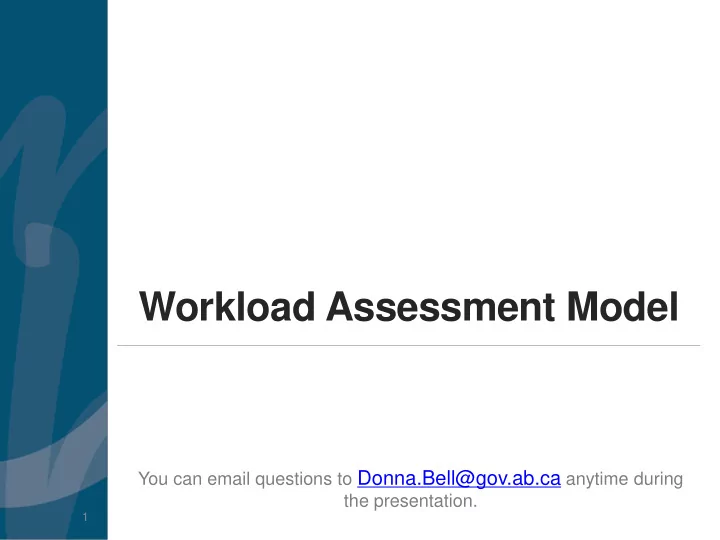

Workload Assessment Model You can email questions to Donna.Bell@gov.ab.ca anytime during the presentation. 1
Workload Management in Human Services 2015: Revision of CI Resource Forecast and Benchmarks 2013: OPT Resource Forecasting Model 2011: Workload 2010: Resource Forecasting Model Benchmarks for CI, FC, for FC, Adoption, CC and FSCD Adoption, CC and FSCD 1999: Workload Standards Development Project Report 2008: Resource Forecasting Model for CI 2003: Foster Care Workload Study 1991: Workload Study-101 Standards Note: 1. Year indicates calendar year of project completion. 2. This list of milestones may not be comprehensive. 2
Evolution of Child Intervention Practice 2014: Signs of Safety implemented Practice Strategies implemented 2013: Prevention & Early Intervention Framework begins 2013: Front End & Practice Strategies Piloted 2012: Work on Child Intervention Practice Framework begins 2005: Alberta Response Model / Differential Response 2010: OBSD is Implemented in Central, North Central, Northwest, South 2009: ISIS Implementation begins 2004: Child and Family Enhancement Act 2009: Outcome Based Service Delivery Implementation in Calgary & Edmonton 1998: CFSAs created Note: 1. Year indicates calendar year of project completion. 2. This list of milestones may not be comprehensive. 3
What is the Workload Assessment Model? o The model represents a holistic approach to managing workload using a number of complimentary strategies for a variety of roles. Case Intensity Rating Work Breakdown Structure Strategies Activity Time Estimates Resource Forecasting Model Role Based Workload Benchmarks CI Intake Worker CI Assessor Roles CI Case Manager CI Generalist CI Permanency Worker
Project Design o Key features of methodology: Case complexity considerations Quantitative and qualitative analysis Workload considerations (non-case work) o Stakeholder Engagement and Collaboration: Fifteen Work Group members representing all regions, CI roles, program policy, HR and Sub 006 Eight workshops Discussions on foundational topics Staff involvement through provincial survey of 120 staff participants Regular Communication with key stakeholders
Benchmarks 2011 Benchmarks 2015 Notes: 1. These benchmarks are based on activity time estimate data collected between Jan-Mar 2015. 2. An active case for Intake and Assessment relates to a family in the process; active case for Case Management relates to a child in the process. 6 3. The Reference Period is the turnaround days for the phase/work as in current policy. * Assessor and Permanency roles require further minor validation.
Change Approach 1. Collaboration - Consultation Committee comprising of representatives from key stakeholder groups. 2. Consultative: Workshops and discussions within the committee and with stakeholders at large. 3. Purposeful: Conduct assessment of impact on stakeholders Develop recommendations on implementation, address stakeholder concerns and interests. Rollout of new benchmarks, training, workload allocation process, workload balancing approach, non-formal issue escalation process. Communication and change management Assess implications or impacts w.r.t. CCISD and other HS programs 4. Build consensus and get approvals. 5. Incremental approach to roll-out and implementation.
Critical Success Factors 1. Executive support for the change. 2. Collaborative approach that includes all affected stakeholders as partners. 3. Enterprise approach, resolve it like a collective problem and opportunity. 4. Transparency and clarity of intent and purpose. 5. Communications and messaging to emphasize: - What’s in it for me for each stakeholder group - Uses and exceptions for workload benchmarks 6. Training and education to workers and supervisors. 7. Focus on workload balancing as a continuous operational process, not an event triggered by appeals or grievance. 8. A practical rollout and implementation approach – e.g. pilot sites, allow a stabilization period etc.
9
10
Thank You! 11
Recommend
More recommend